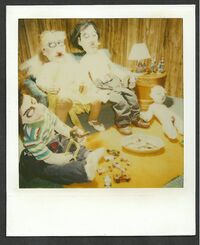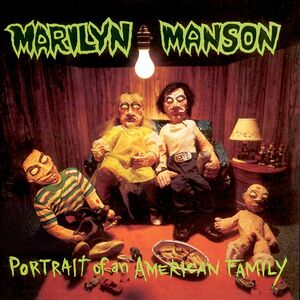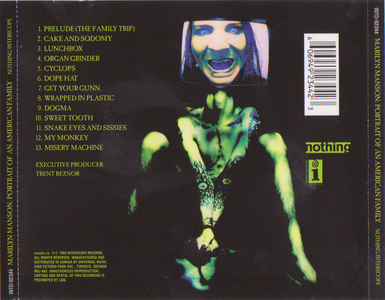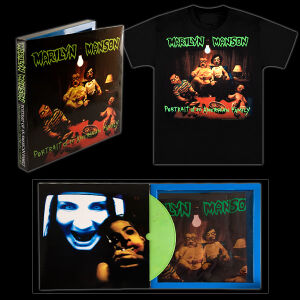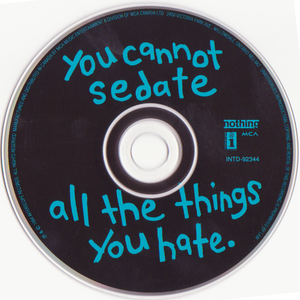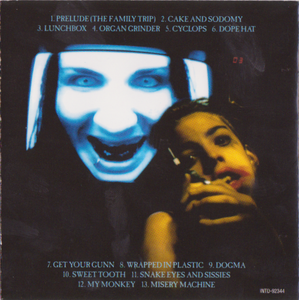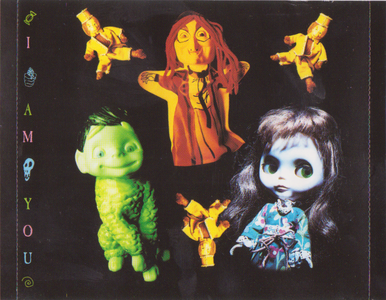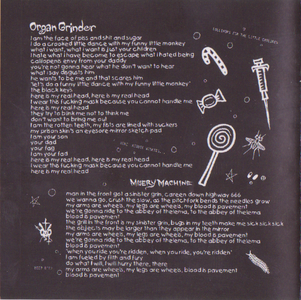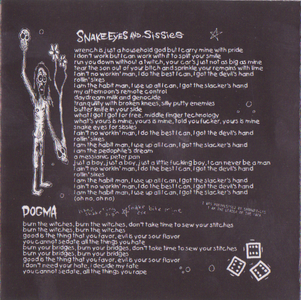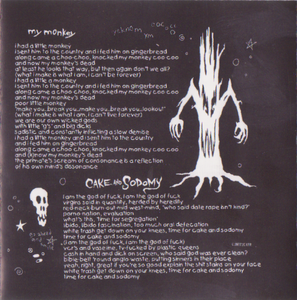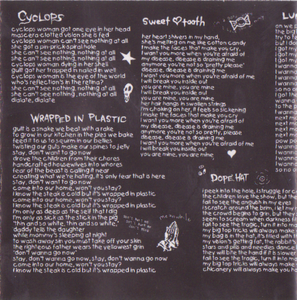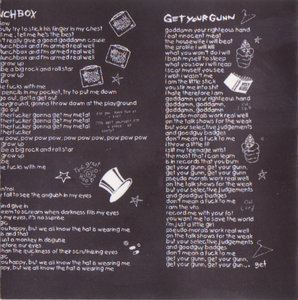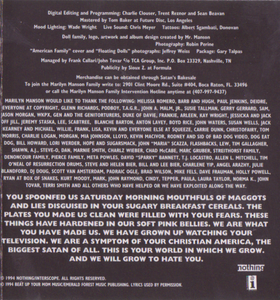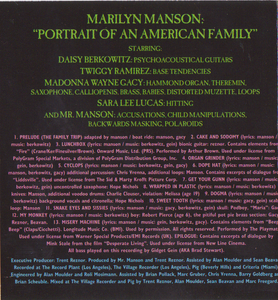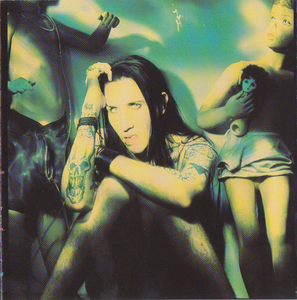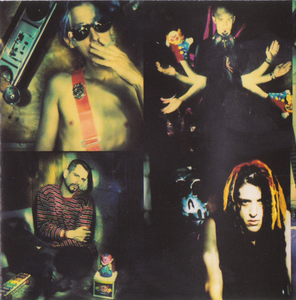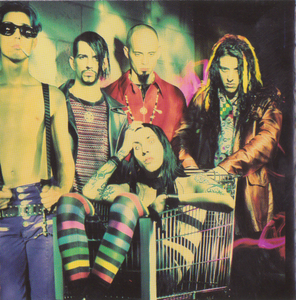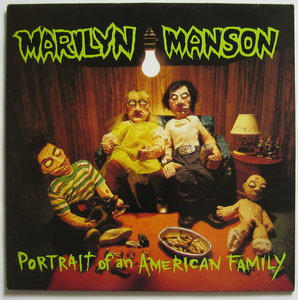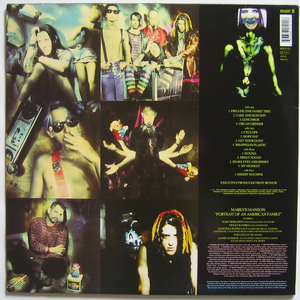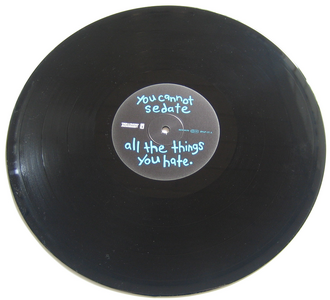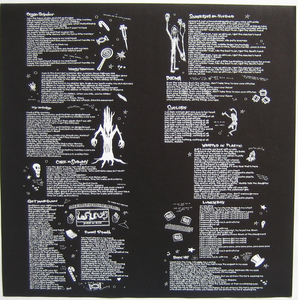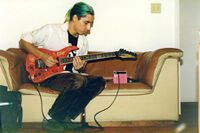Portrait of an American Family (album)
| Portrait of an American Family | |||||
|---|---|---|---|---|---|
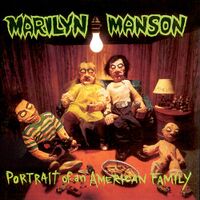
|
|||||
| Studio album by Marilyn Manson | |||||
| Released | July 19, 1994 (29 years ago) | ||||
| Recorded | August–December 1993 at Criteria Studios in Miami, Florida, Record Plant Studios in Los Angeles, California, The Village Recorder and Pig | ||||
| Genre | Alternative metal, heavy metal, hard rock | ||||
| Length | 61:05 | ||||
| Label | Nothing, Interscope | ||||
| Producer | Marilyn Manson, Trent Reznor | ||||
| Discogs | |||||
| Marilyn Manson chronology | |||||
|
|||||
Portrait of an American Family is the debut full-length studio album by American rock band Marilyn Manson. It was released on July 19, 1994 in the US through Nothing and Interscope Records. It was produced by the band's frontman and Trent Reznor of Nine Inch Nails. The album was initially known as The Manson Family Album—a direct reference to serial killer Charles Manson's own band—but was retitled prior to release.
It is the first and only Marilyn Manson studio album that bassist Gidget Gein plays on. Gein was fired from the band after its production following a very public and destructive heroin addiction and Twiggy Ramirez, the band's groupie and friend of Gein and Manson, was put as a temporary replacement while Gein got clean and sober. He eventually took over Gein's place, becoming a Gein clone. Contrary to popular belief, Ramirez did not play bass on the album. Though Sara Lee Lucas was the featured drummer on the album, Nine Inch Nails live keyboardist Charlie Clouser used a drum machine to replace the work Lucas did. Daisy Berkowitz helped compose music for all of the songs except "Prelude (The Family Trip)" and "Sweet Tooth."
The album has sold over 2.5 million copies worldwide and was certified Gold on May 29, 2003 by the Recording Industry Association of America (RIAA) for shipments of over 500,000 copies in the United States.[1] It spawned three singles ("Get Your Gunn", "Lunchbox" and "Dope Hat").
In late 2009, it was re-released by Interscope and sold through Hot Topic stores as a special edition box set combination of a T-shirt bearing the album artwork and a mint-green vinyl LP record of the album. The color of the disc is light green, nearly matching the coloration of most of the bands fonts at the time of the album's original 1994 release; however, this reissue featured some imagery from The High End of Low on its label, much to the dismay of fans.[2]
Contents
Background[edit]
The Manson Family Album[edit]
- Main article: The Manson Family Album
| “ | When we were finally finished, Roli had done the opposite of what I'd expected. I thought he was going to bring out some sort of darker element. But he was trying to polish all the rough edges and make us more of a rock band, a pop band, which at the time I wasn't interested in at all. I thought the record we did with him came out bland and lifeless. Trent thought the same thing so he volunteered to help us repair what had been damaged.[3] | ” |
| —Marilyn Manson discussing the aftermath of the album's initial recording sessions. | ||
Recording sessions for its national debut, Portrait of an American Family, began in July 1993. Working with producer Roli Mosimann at Criteria Stundios in Miami, Florida,[3] the band recorded a selection of new songs along with reworked material from their Spooky Kids repertoire and, by the end of Autumn 1993, had completed the first version of their debut, a full album's worth of material collectively known as The Manson Family Album.[4] At the time, "Snake Eyes and Sissies" was on track to be the band's first single, with a single edit having already been made. However the band was simply not satisfied with the output of these recording sessions and shelved the album for a short time.[5]
Within a few months, the band would convince rising star Trent Reznor to produce the album instead.[6] The abrasive sonic "rawness" that Mosimann's production had brought to such groups as Swans had failed to materialize on The Manson Family Album; Reznor and all the band's members thought it "sucked", and was poorly representative of Marilyn Manson's dynamic live performances.[3][7] In October 1993, Reznor agreed to fully commit to the project, taking them and their tapes to various studios in Los Angeles. With the help of Reznor and numerous live members of his band, Nine Inch Nails, Marilyn Manson re-recorded and reworked their old material until they were satisfied and released it under the name Portrait of an American Family.[8] "Snake Eyes and Sissies" would never see a single release and in the album's credits Mosimann is credited as an engineer with no mention of his production work.
Years later, former guitarist Daisy Berkowitz was asked about these original recordings in an interview and gave the interviewer a cassette tape featuring the unused recordings. The interviewer then released them to the Internet where they are now widely available, usually labeled as Portrait of an American Family (Pre-Reznor Mix) or Portrait of an American Family Demos.
Themes[edit]
The band's frontman has discussed his thoughts in retrospect on Portrait of an American Family with Empyrean Magazine, circa May/June 1995:
| “ | Well, the whole point of [Portrait of an American Family] was that I wanted to say a lot of the things I've said in interviews [...] But I wanted to address the hypocrisy of talk show America, how morals are worn as a badge to make you look good and how it's so much easier to talk about your beliefs than to live up to them. I was very much wrapped up in the concept that as kids growing up, a lot of the things that we're presented with have deeper meanings than our parents would like us to see, like Willy Wonka and the Brothers Grimm. So what I was trying to point out was that when our parents hide the truth from us, it's more damaging than if they were to expose us to things like Marilyn Manson in the first place." | ” |
| —Marilyn Manson Manson & Strauss 1998, p. 151 | ||
Music[edit]
Songs[edit]
"Cake and Sodomy" is the second track on the album. In 1990, Manson met a woman at a McDonald's restaurant in Fort Lauderdale who invited him to spend a weekend with her in New York City. Upon discovering that the girl was using her sister's ID because she was too young to work, Manson abandoned her, shortly after which he ran into two clubbers from South Florida. Manson spent the remainder of his stay in New York at the clubbers' hotel room, where he stumbled on Public-access television cable TV channels, which were "a completely new phenomenon" to him. Manson "spent hours flipping through the station, watching Pat Robertson preach about society's evils and then ask people to call him with their credit card number," while "on the other channel, a guy was greasing up his cock with Vaseline and asking people to call and give him their credit card number." This inspired Manson to grab the hotel notepad and begin penning the song's lyrics. Manson explains in his autobiography The Long Hard Road Out of Hell that "I had written other songs I thought were good, but "Cake and Sodomy" was more than just a good song. As an anthem for the hypocritical America slobbering on the tit of Christianity, it was a blueprint for our future message."[9]
"Lunchbox" is the second single and the third track of the album. It was inspired by a piece of legislation dating back to 1972, which makes it illegal to have metal lunchboxes in schools. The song tells the story of a school age child who is bullied and uses his own lunchbox as a weapon in retaliation, waiting for the day he can "grow up to be a big rock and roll star" who is never intimidated by others. The earliest recording of this song dates back to the band's After School Special cassette tape, released in January 1991. The album version of "Lunchbox" samples The Crazy World of Arthur Brown song "Fire".
"Dope Hat" is the third and final single and the sixth track of the album. The earliest recording of this song dates back to the band's The Family Jams cassette, released in 1992. Whilst the band's keyboardist Madonna Wayne Gacy was given a music credit for the song on Portrait of an American Family, curiously his name is absent from the credits of The Family Jams and Refrigerator, two cassettes a demo of "Dope Hat" had appeared on beforehand. The single's release was accompanied by a music video which featured Manson in the role of Willy Wonka in a shock-horror version of Willy Wonka & the Chocolate Factory.
"Get Your Gunn" is the first single and the seventh track of the album. The song was inspired by the murder of OB/GYN doctor David Gunn who was killed in Florida by an anti-choice activist. The frontman later described his murder as "the ultimate hypocrisy I witnessed growing up: that these people killed someone in the name of being 'pro-life'".[10]
"Wrapped in Plastic" is the eighth track on the album. The earliest recording of this song dates back to the band's Refrigerator cassette tape, released in 1993. It recycles lyrics from an earlier Spooky Kids song, "I.V.-T.V.". The frontman has stated that "Wrapped in Plastic" is about his past at his grandfather's basement. The version on Refrigerator cassette gives the listener better detail of this fact.
"Sweet Tooth" is the tenth song on the album, and the only song that former bassist Gidget Gein wrote both guitar and bass parts for. However, of all the album tracks, "Sweet Tooth" was the only one not regularly played live.
"Snake Eyes and Sissies" is the eleventh track on the album. Though "Snake Eyes and Sissies" was once considered important enough to be a potential single, it was never given a proper release and has not been played by the band since the Smells Like Children tour in 1995/1996.
"My Monkey" is the twelfth track on the album. Several verses were taken from "Mechanical Man" written and performed by Charles Manson in 1968; the lyrics of "My Monkey" are credited simply to "Manson". The earliest recording of this song dates back to the band's The Beaver Meat Cleaver Beat cassette tape, released in 1990.
"Misery Machine" is the thirteenth and final track on the album, and is a direct reference to the Mystery Machine from the animated television series Scooby-Doo. Imagery from the cartoon was prevalent in the early years of the band, having been used in various flyers among other similar cartoon characters.
Samples[edit]
| “ | "One strange thing that happened was we were mixing the song "Wrapped in Plastic". [...] We were using a computer because we had a lot of samples and sequencing. While we were working on that song the Charles Manson samples from "My Monkey" started appearing in the mix. All of a sudden we'd hear in the song, 'Why does a child reach up and kill his mom and dad?' And we couldn't figure what was going on. The chorus of "Wrapped in Plastic" is, 'Come into our home/Won't you stay?' And we're in the Sharon Tate house, just me and Sean Beavan [the record's assistant producer]. We totally got scared and we're like, 'We are done for the night.' We came back the next day and it was fine. The Charles Manson samples weren't even on the tape anymore. There's no real logical or technological explanation for why they appeared. It was a truly supernatural moment that freaked me out.[8] | ” |
| —Marilyn Manson discussing paranormal behavior during the album's production. | ||
The album has an especially wide array of American cultural references. The words "Go on and smile, you cunt" at the beginning of "Cake and Sodomy" are spoken by Marlon Brando in the film Last Tango in Paris. In the song "Dogma", there is a sample from the John Waters film Pink Flamingos, when Mink Stole's character says "Burn, you fucker!" before setting fire to a trailer. Although the clip from Desperate Living is credited in the liner notes, this audio clip is not. Furthermore, John Waters was thanked in the liner notes. The phrase "We're gonna ride to the Abbey of Thelema" in the song "Misery Machine" is a reference to Aleister Crowley's Abbey of Thelema, which was used as the Headquarters from which the doctrines of Thelema would be spread throughout the world.
The track "My Monkey" borrows certain lyrics from a Charles Manson song called "Mechanical Man;" the lyrics of "My Monkey" are credited simply to "Manson". At 02:29 of "Get Your Gunn", there is a sample of a crowd murmuring and a gun shot. This is the audio from the press conference in which Budd Dwyer committed suicide in front of an audience. The words to "Prelude (The Family Trip)" come from Roald Dahl's book Charlie and the Chocolate Factory. Also, the printing of Marilyn Manson on various promos during this time and on the remix album Smells Like Children resemble the printing of the title to the 1971 film version of the novel.
"Killing is killing, whether done for duty, profit or fun" is a quote by Richard Ramirez that is an audio clip at the start of "Snake Eyes and Sissies". "Organ Grinder" features the sample "Lollipops for the kiddie winkies," spoken by the Child Catcher from the movie Chitty Chitty Bang Bang. At the start of "Cyclops" there is a very slowed down and distorted sample of the preacher from Poltergeist II singing "God Is In His Holy Temple". "Dope Hat" contains the samples "the great Hoodoo!" and "Prepare to meet your doom" taken from the Sid and Marty Krofft cult TV show Lidsville. These words are spoken by the actor Charles Nelson Reilly. "Lunchbox" contains the sample "I bring you fire!" from the song "Fire" by The Crazy World of Arthur Brown. "Misery Machine" contains a sample from "Beep Beep" by The Playmates. "Wrapped in Plastic" is influenced by Twin Peaks, referencing the image of character Laura Palmer wrapped in plastic, which was one of the show's most enduring images. It also featured the distorted words "Hallelujah" and "Meanwhile" from the Twin Peaks scene in the Black Lodge. This is followed by the distinctive scream of Laura Palmer.
In Marilyn Manson book, The Long Hard Road Out of Hell, he describes that Wrapped In Plastic is a song that's about his past at his grandfather's basement and the scream in the end of the song is Manson's voice distorted and backwards. The family jams version of the song gives the listener better detail of this fact.
Promotion[edit]
To promote the album, Interscope held two separate release parties for music journalists and fan club members – the first of these was held less than a month before its commercial release in Fort Lauderdale, Florida on June 29, 1994, whilst the second took place a day before the record's scheduled date in Plantation, Florida on July 18, 1994.
Release[edit]
Singles[edit]
Portrait of an American Family was anchored by two singles, "Get Your Gunn" and "Lunchbox", along with "Dope Hat" which was issued to radio and music video channels without a commercial single release. A total of three singles were spawned from the album.
The music video for "Get Your Gunn", directed by Rod Chong, features the band performing in a damp "attic-like" scene, intertwined by footage of two feisty teenage girls. It did not receive much airplay.
The music video for "Lunchbox" directed by Richard Kern, features a boy being bullied by two older students. The boy goes home, fed up with the way he is treated, and shaves his head into a mohawk hairstyle and prepares for any future retaliation against the bullies with his metal lunchbox. The boy later goes to the rollerskating rink where the band is performing. The boy gives Manson his lunchbox, which Manson lights on fire and parades around. The video ends with the boy staring into the burning lunchbox. It is one of the few music videos with Manson performing without wearing makeup, alongside "Get Your Gunn" and "Tourniquet".
The music video for "Dope Hat", directed by Tom Stern, features the band riding a boat through a psychedelic tunnel directly inspired by the 1971 film Willy Wonka & the Chocolate Factory, which happens to be one of Manson's favorite films. In the video, the band members perform with many children and people resembling the Oompa-Loompas from the film aboard the boat.
Cover and packaging[edit]
| “ | "I wanted to use a photo in [the album]'s booklet of me naked on a couch when I was a kid. When you hold up something to people, usually what they see in it is what's inside them in the first place. And that's what happened because the lawyers at Interscope said, 'First off, that picture's going to be considered child pornography, and not only will no stores carry the album but we're subject to legal retribution from it.' They said if a judge were to look at it, the law states that if a photograph of a minor elicits sexual excitement then it's considered child pornography. I said, 'That's exactly my point. This is a photograph that was taken by my mother, and it's extremely innocent and very normal. But if you see it as pornography, why am I the guilty person? You're the person who's got a hard-on. Why aren't you punished? That's still a point I'd like to make. People's morality is so ridiculous: If they get excited by it, then it's wrong."[11] | ” |
| —Marilyn Manson discussing Interscope's objection to his initial vision of the album's cover art. | ||
The album's original cover art featured no text, simply a painting of a clown by John Wayne Gacy. The interior photography included Polaroid pictures (faked by Manson and friends) apparently of a mutilated female body, and a photo of what Manson described as "one of those dolls from the '60s and you pull a string on the back of it and the eyes get really big and they change colors."[11]
In the early stages of the album's conception, Manson intended to use a picture of himself as a child sitting nude on a couch in the album's interior artwork. Though no genitalia is shown in the picture, and it was taken by his own parents with no vulgar intent, the label rejected the idea on the grounds that it could constitute as child pornography, so Manson instead created the clay sculpture present on the final cover artwork of the album. On the table on this sculpture, there are little models of The Beatles next to the lamp. The boy in the photograph on the back cover is Ramirez's half-brother Wes Brown. He's holding an ear-piercing needle rather than a syringe. Portrait of an American Family is notable for being the band's only studio album not to feature an image of Manson on the cover. However, Manson did eventually use a nude photo of himself as an adult for the inside flap photo for the CD single for "Lunchbox" but did not expose his genitals.
By the time the album became Portrait of an American Family, the ideas of using Gacy's clown artwork and the nude photograph was dropped completely.
Reception[edit]
Critical reception[edit]
| Professional ratings | |
|---|---|
| Review scores | |
| Source | Rating |
| allmusic | |
| Rolling Stone | |
Upon its release, the album met with mixed reviews from music critics. Stephen Thomas Erlewine of allmusic gave the album a favorable review but noted that "even a few years on from its 1994 release, Portrait of an American Family began to sound a little dated, especially since its Nine Inch Nails-meets-W.A.S.P.-meets-Alice Cooper formula was fully realized on Manson's follow-up album, Antichrist Superstar. Here, it's in sketch form, and by the end of the album it's clear that Warner, Manson, whatever you want to call him, needs a full canvas to truly wreak havoc."[12] Rolling Stone gave the album a negative review and said that "Manson's debut [...] isn't the sharply rendered cultural critique of America he'd like you to think it is. Most of the record comes off like some low-budget horror movie.[13]
Portrait of an American Family Tour[edit]
- Main article: Portrait of an American Family (tour)
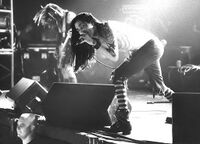
Prior to embarking on any official tour under the wing of a major label, Marilyn Manson spent several years touring independently at various locations in Florida such as Fort Lauderdale, Boca Raton, Miami Beach, South Hallandale and Davie, among various other one-night venues. During this time, the band is known to have left Florida only three times to perform. Until August 1992, the band played these shows as Marilyn Manson & the Spooky Kids. The band played these independent shows from April 28, 1990 until June 4, 1994. During the Spooky Kids-era, the concerts featured several antics among which were girls covered in blood and wearing animal masks whilst locked in metal cages, women ironing Nazi flags onstage and Gacy's renowned keyboard paraphernalia, such as children's toys and dismembered doll heads.[14]
Nine Inch Nails' Self Destruct tour was the first tour Marilyn Manson embarked on, now under management of major record label Interscope Records. They were an opening act for Nine Inch Nails. The band was on the tour from April 24, 1994 until December 11, 1994.
The Portrait of an American Family Tour was the second tour Marilyn Manson embarked on. It was also the band's first headlining tour under a major label. The band was on the tour from December 27, 1994 until March 11, 1995. During these concerts, the stage usually was arranged like a living room, much like the one on the album cover artwork. A table with a lamp, candy canes and multiple six-sided dice were the most commonly seen props.
Track listing[edit]
- 1. "Prelude (The Family Trip)" – 1:20
- 2. "Cake and Sodomy" – 3:46
- 3. "Lunchbox" – 4:32
- 4. "Organ Grinder" – 4:22
- 5. "Cyclops" – 3:32
- 6. "Dope Hat" – 4:21
- 7. "Get Your Gunn" – 3:18
- 8. "Wrapped in Plastic" – 5:35
- 9. "Dogma" – 3:22
- 10. "Sweet Tooth" – 5:03
- 11. "Snake Eyes and Sissies" – 4:07
- 12. "My Monkey" – 4:31
- 13. "Misery Machine" – 13:11
Argentinian Bonus tracks[edit]
- 14. "Down in the Park" – 5:00
- 15. "Brown Bag" – 6:19
Album credits[edit]
MARILYN MANSON:
"PORTRAIT OF AN AMERICAN FAMILY"
Starring:
DAISY BERKOWITZ: PSYCHOACOUSTICAL GUITARS
TWIGGY RAMIREZ: BASE TENDENCIES
MADONNA WAYNE GACY: HAMMOND ORGAN, THEREMIN, SAXOPHONE, CALLIOPENIS, BRASS, BABIES, DISTORTED MUZETTE, LOOPS
SARA LEE LUCAS: HITTING
/ music: berkowitz) 3. LUNCHBOX (lyrics: manson / music: berkowitz, gein) bionic guitar: reznor. Contains elements from
"Fire" (Crane/Finesilver/Brown). Onward Music, Ltd. (PRS). Performed by Arthur Brown. Used under license from
PolyGram Special Markets, a division of PolyGram Distribution Group, Inc. 4. ORGAN GRINDER (lyrics: manson / music:
gein, berkowitz) 5. CYCLOPS (lyrics: manson / music: berkowitz, gein, gacy) 6. DOPE HAT (lyrics: manson / music:
manson, berkowitz, gacy) additional percussion: Chris Vrenna, additional loops: Manson. Contains excerpts of dialogue from
"Liddsville". Used under license from The Sid & Marty Krofft Picture Corp. 7. GET YOUR GUNN (lyrics: manson / music:
berkowitz, gein) uncontrolled saxophone: Hope Nichols 8. WRAPPED IN PLASTIC (lyrics: manson / music: berkowitz)
knives: Manson, additional voodoo drums Charlie Clouser, violation: Melissa (age 19) 9. DOGMA (lyrics: manson / music:
berkowitz) background vocals and citronella: Hope Nichols 10. SWEET TOOTH (lyrics: manson / music: gacy, gein) scab
loop: Manson 11. SNAKE EYES AND SISSIES (lyrics: manson / music: gacy, berkowitz, gein) skull: Podboy, "Maria": Gacy
12. MY MONKEY (lyrics: manson / music: berkowitz) boy: Robert Pierce (age 6), the pitiful pot pie brass section: Gacy,
Reznor, Beavan. 13. MISERY MACHINE (lyrics: manson / music: gein, berkowitz, gacy). Contains elements from "Beep,
Beep" (Claps/Cicchetti). Longtitude Music Co. (BMI). Used by permission. All rights reserved. Performed by The Playmates.
Used under license from Warner Special Products/EMI Records (UK). EPILOGUE: Contains excerpts of dialogue by
Mink Stole from the film "Desperate Living". Used under license from New Line Cinema.
All bass played on this recording by Gidget Gein (AKA Brad Stewart).
Recorded at The Record Plant (Los Angeles), The Village Recorder (Los Angeles), Pig (Beverly Hills) and Criteria (Miami).
Engineered by Alan Moulder and Roli Mosimann. Assisted by Brian Pollack, Marc Gruber, Chris Vrenna, Barry Goldberg and
Brian Scheuble. Mixed at The Village Recorder and Pig by Trent Reznor, Alan Moulder, Sean Beavan and Marc Freegard.
Mastered by Tom Baker at Future Disc, Los Angeles
Photography: Robin Perine
Publicity by Sioux Z. at Formula
To join the Marilyn Manson Family write to: 2901 Clint Moore Rd., Suite #404, Boca Raton, FL. 33496 or call the Marilyn Manson Family Intervention Hotline anytime at (407-997-9437)
EVERYONE AT COPYRIGHT, GLENN RICHARDS, PODBOY, T.A.G.R, JOHN A. MALM, JR,. SUSIE TALLMAN, GERRY GERRARD, SAM,
JASON MORGAN, WKPX, GEN AND THE GENITORTURERS, DUKE OF DAVIE, FRANKIE, ARLEEN, KAY WRIGHT, JESSICKA AND JACK
OFF JILL, JEREMY STASKA, LEE, SCABTREE, BLANCHE BARTON, ANTON LAVEY, BOYD RICE, JOHN WATERS, SUSAN WELLS, JACK
KEARNEY AND MICHAEL, WILLIE, FRANK, LISA, KEVIN AND EVERYONE ELSE AT SQUEEZE, CARRIE DUNN, CHRISTOFAIRY, TOM
MORRIS, CHARLIE LOGAN, MORGAN, MIA JOHNSON, LLOYD, KEVIN MACIVOR, RODNEY, AND SID OF BAD DOG VIDEO, DOG EAT
DOG, BILL HOWARD, LORI WERDER, HOPE AND SUGARSMACK, JOHN "MARIA" SCAZZA, FLASHBACKS, LEW, TIM GALLAGHER,
SHAWN, A.J., STEVE-O, DAN, MARNIE SMITH, CHARLZ WIEBER, CHAD McCABE, MARC GRUBER, STREITHORST FAMILY,
DENONCOUR FAMILY, PIERCE FAMILY, META POWLES, DAVID "SPARKY" BANNETT, T.J. LOCASTRO, ALLEN L. MITCHELL, TIM
O'NEAL OF RESURRECTION DRUMS, STEVE AND HELEN BIER, BILL AND LEE BIER, CHARLENE YIP, ANGEL ARAZHY, JULIE
BLANDFORD, GJ DOUG, SCOTT VAN AMSTERDAM, PDRAIC OGLE, BRAD WILSON, MIKE FELS, DAVE FRAUMAN, HOLLY POWELL,
RYAN AT BOX OF SNAKES, KURT MOODY, MARK, JOHN RAYMOND, CINDY, TEPPER, PAULA, LAURA TAYLOR, NORMA K., JOHN
TOVAR, TERRI SMITH AND ALL OTHERS WHO HAVE HELPED OR WE HAVE EXPLOITED ALONG THE WAY.
AND LIES DISGUISED IN YOUR SUGARY BREAKFAST CEREALS. THE
PLATES YOU MADE US CLEAN WERE FILLED WITH YOUR FEARS. THESE
THINGS HAVE HARDENED IN OUR SOFT PINK BELLIES. WE ARE WHAT
YOU HAVE MADE US. WE HAVE GROWN UP WATCHING YOUR
TELEVISION. WE ARE A SYMPTOM OF YOUR CHRISTIAN AMERICA, THE
BIGGEST SATAN OF ALL. THIS IS YOUR WORLD IN WHICH WE GROW.
AND WE WILL GROW TO HATE YOU.
© 1994 BEAT UP YOUR MOM MUSIC/EMERALD FOREST MUSIC PUBLISHING. LYRICS USED BY PERMISSION.
Cover gallery[edit]
Charts and certifications[edit]
Album charts[edit]
| Charts (1995) | Peak position |
|---|---|
| Billboard Top Heatseekers[15] | 35 |
Singles[edit]
| Single | Chart (1997) | Peak position |
|---|---|---|
| "Get Your Gunn" | Billboard Canadian Singles Chart[16] | 11 |
| "Lunchbox" | Billboard Canadian Singles Chart[16] | 5 |
Trivia[edit]
- "Snake Eyes and Sissies" was originally planned as the lead single but never released; "Get Your Gunn" was released instead. It also was originally 5:09, and had extra lyrics.
- Portrait of an American Family is the band's only studio album in which Marilyn Manson does not appear on the cover. He did however create the clay sculpture shown in the art.
- Manson had initially wanted to put a nude photo of himself as a child for the album artwork. Interscope deemed it would be seen as child pornography, so Manson created the album artwork with the clay figures.
- Although there are technically no hidden tracks on the album, there is some additional audio a few seconds after the end of last track, "Misery Machine". The sample, "Go home to your mother! Doesn't she ever watch you!? Tell her this isn't some Communist day-care center! Tell your mother I hate her! Tell your mother I hate you!" is spoken by Mink Stole from the John Waters 1977 film "Desperate Living". After this, a telephone can be heard ringing very quietly for several minutes, which is then followed an irate answering machine message, presumably from a parent of a Manson fan.
- Bassist Gidget Gein was fired after the production of this album.
- Daisy Berkowitz helped compose music for all of the songs except "Prelude (The Family Trip)" and "Sweet Tooth".
- Roli Mosimann was the original producer of the album, however due to the direction the album was taking the band felt his production was not what they were looking for and Trent Reznor took over the producer role while Mossiman was credited as the engineer.
- The album's original title was The Manson Family Album.
- The song "Filth" was planned to be officially released on Portrait of an American Family but was replaced by "Wrapped in Plastic" instead, and this Reznor-produced version has never been officially released.
- The track "My Monkey" is different from the one on Big Black Bus.
- One of the release parties for the album was held in Fort Lauderdale, Florida on June 29th, 1994.
- One of the release parties for the album was held in Plantation, Florida on July 18th, 1994.
- In late 2009, Hot Topic stores began selling a combination set of a t-shirt baring the album artwork and colored vinyl of the album. The color of the vinyl is green, matching most fonts from the time.
Credits and personnel[edit]
|
|
References[edit]
- Footnotes
- ↑ "RIAA Database Search for Marilyn Manson". Recording Industry Association of America. http://riaa.com/goldandplatinumdata.php?resultpage=1&table=SEARCH_RESULTS&action=&title=Portrait%20Of%20An%20American%20Family&artist=Marilyn%20Manson&format=&debutLP=&category=&sex=&releaseDate=&requestNo=&type=&level=&label=&company=&certificationDate=&awardDescription=&catalogNo=&aSex=&rec_id=&charField=&gold=&platinum=&multiPlat=&level2=&certDate=&album=&id=&after=&before=&startMonth=1&endMonth=1&startYear=1958&endYear=2010&sort=Artist&perPage=25. Retrieved 2008-08-14.
- ↑ "Portrait of an American Family [Limited Edition Vinyl Box set with T-Shirt]". Amazon. http://www.amazon.com/Portrait-American-Family-Limited-T-Shirt/dp/B00336KECM/ref=sr_1_3?s=music&ie=UTF8&qid=1306154017&sr=1-3. Retrieved 2011-05-23.
- ↑ 3.0 3.1 3.2 Manson & Strauss 1998, p. 144
- ↑ Manson & Strauss 1998, p. 123
- ↑ Manson & Strauss 1998, p. 128
- ↑ Manson & Strauss 1998, p. 134
- ↑ Greg, Baker (1994-07-20). "Manson Family Values" (Tabloid). Miami New Times (Village Voice Media, Inc.). http://www.miaminewtimes.com/issues/1994-07-20/music/music3.html. Retrieved 2006-09-09.
- ↑ 8.0 8.1 Manson & Strauss 1998, p. 147
- ↑ Manson & Strauss 1998, p. 95
- ↑ Marilyn Manson (1999-05-28). "Columbine: Whose Fault Is It?". Rolling Stone (Wenner Media LLC) (815).
- ↑ 11.0 11.1 Manson & Strauss 1998, p. 150
- ↑ 12.0 12.1 Erlewine, Stephen Thomas. "Portrait of an American Family review". allmusic. All Media Guide (Rovi). https://www.allmusic.com/album/portrait-of-an-american-family-r204446/review. Retrieved 2011-06-28.
- ↑ 13.0 13.1 "Rolling Stone Album Guide for Marilyn Manson". Rolling Stone. Wenner Media LLC. http://www.rollingstone.com/music/artists/marilyn-manson/albumguide. Retrieved 2011-06-28.
- ↑ Manson & Strauss 1998, p. 115-116; 122
- ↑ "Portrait of an American Family Charts & Awards". allmusic. All Media Guide (Rovi). https://www.allmusic.com/album/portrait-of-an-american-family-r204446/charts-awards/billboard-album. Retrieved 2011-05-23.
- ↑ 16.0 16.1 "Portrait of an American Family Charts & Awards Billboard Singles". allmusic. All Media Guide (Rovi). https://www.allmusic.com/album/portrait-of-an-american-family-r204446/charts-awards/billboard-single. Retrieved 2011-05-23.
- ↑ 17.0 17.1 "Portrait of an American Family credits". allmusic. All Media Guide (Rovi). https://www.allmusic.com/album/portrait-of-an-american-family-r204446/credits. Retrieved 2011-05-23.
- Bibliography
- Manson, Marilyn; Strauss, Neil (February 14, 1998). The Long Hard Road Out of Hell. New York: HarperCollins division ReganBooks. ISBN 0-06-039258-4.
